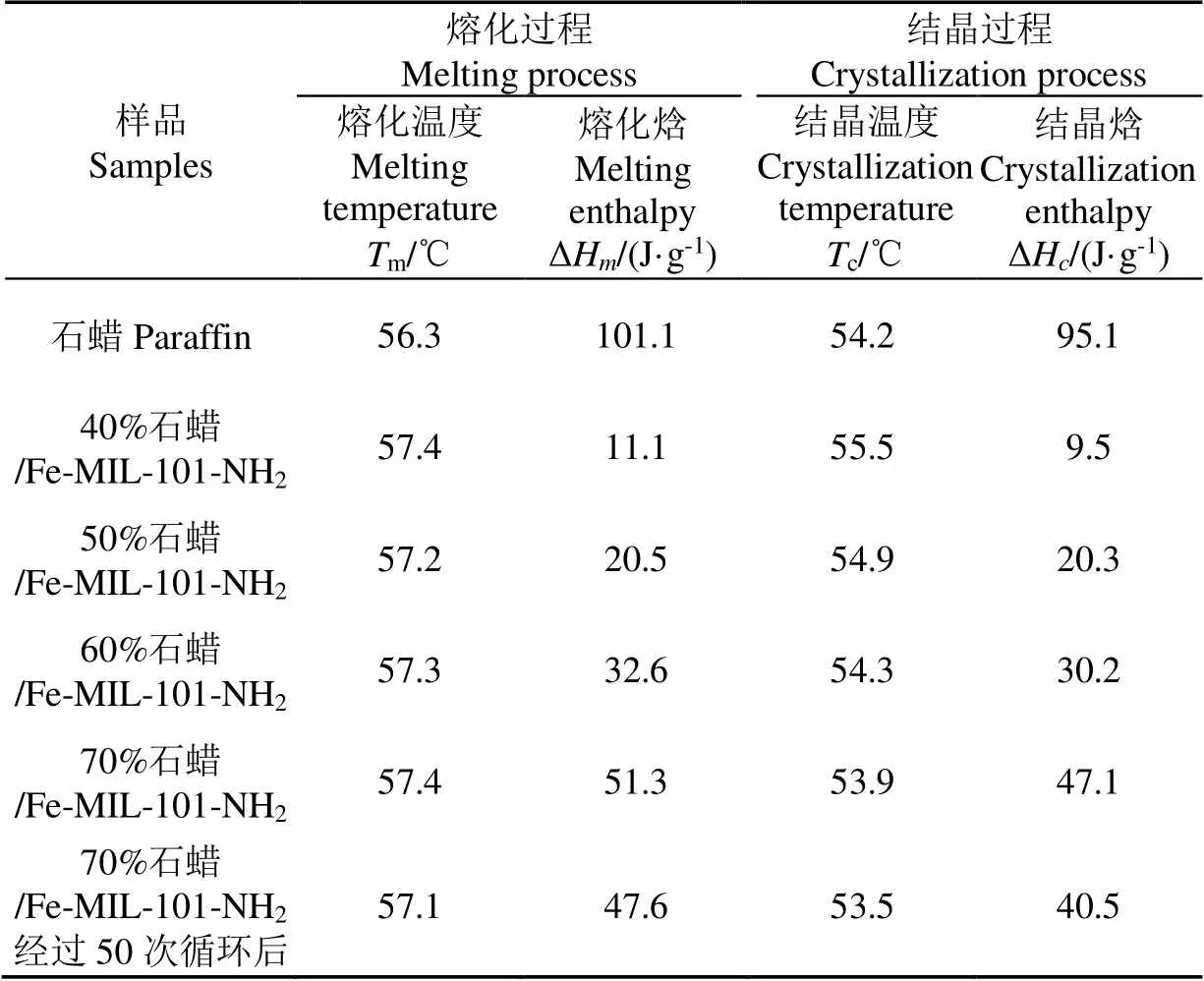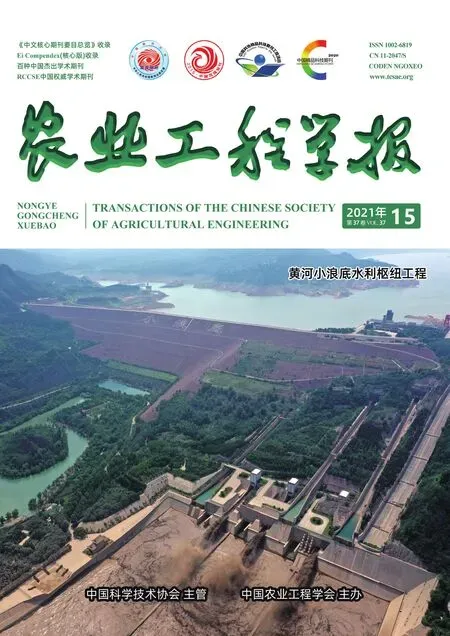石蜡/Fe-MIL-101-NH2金属有机骨架定形复合相变材料制备
侯俊英,杨金星,郝建军,占志国,王雅雅
石蜡/Fe-MIL-101-NH2金属有机骨架定形复合相变材料制备
侯俊英,杨金星,郝建军,占志国,王雅雅
(河北农业大学机电工程学院,保定 071001)
该研究采用石蜡为相变芯材,Fe-MIL-101-NH2金属有机骨架为载体材料,旨在解决石蜡芯材在固-液相变过程中体积变大,从而出现泄漏现象的问题。通过溶剂蒸发法制备了质量分数为40%~70%的石蜡/Fe-MIL-101-NH2定形复合相变材料。采用扫描电子显微镜(Scanning Electron Microscope, SEM)、X射线衍射仪(X-ray Diffraction, XRD)、傅里叶变换红外光谱(Fourier Transform Infrared Spectroscopy, FTIR)对定形复合相变材料的形貌和结构进行观察;用热重分析(Thermogravimetric Analysis, TGA)对定形复合相变材料的热稳定性进行分析;通过差示扫描量热(Differential Scanning Calorimetry, DSC)仪对样品的相变温度、相变焓和热循环稳定性进行测试;SEM结果表明,石蜡的最高负载量为70%,且其均匀分布于Fe-MIL-101-NH2孔道中。XRD、FTIR分析发现石蜡与Fe-MIL-101-NH2之间只是物理混合,没有化学变化;DSC分析可知,质量分数为70%的石蜡/Fe-MIL-101-NH2储能量最大,为51.3 J/g,且质量分数为70%的石蜡/Fe-MIL-101-NH2经过50次循环后,其储能量为47.6 J/g,无明显下降,说明质量分数为70%的石蜡/Fe-MIL-101-NH2具有良好的热循环稳定性,可为相变材料在建筑领域应用研究提供参考。
相变材料;热储能;金属有机骨架;石蜡;Fe-MIL-101-NH2
0 引 言
近年来,全球能源需求和消耗量急剧增加,并达到了前所未有的高水平[1]。不可再生的化石燃料在全球能源消耗中所占比例较大,但会导致严重的环境污染,为了解决此问题,新能源开发和有效利用逐渐成为科学研究的重点之一[2]。热储能技术能够缓解能源供需在时间和空间上的不匹配,提高能源的有效利用率[3]。热储能技术主要分为潜热储能、显热储能和化学储能。其中,潜热储能在储热领域的应用中具有储热容量大、相变温度适宜、热稳定性高等优点,成为最具竞争力的储能技术[4]。
相变储能时潜热储能中最重要的一种储能方式,其中,相变材料作为相变储能的主体,包括相变芯材和载体材料,相变芯材通常分为液-气、固-液、固-气和固-固四大类材料[5]。其中固-液相变材料因其具有体积变化小、易于后处理、储能密度高等优点引起了研究者的广泛关注。有机相变材料作为固-液相变材料的一种,不仅具有上述优势,而且其廉价易得、无腐蚀性及具有良好的化学热稳定性等[6-7]。石蜡作为一种典型的有机相变芯材,其良好的能量存储密度及恰当的相变温度范围使其在建筑领域具有很好的应用前景。因此本文选用石蜡做为相变芯材。
固-液相变材料在相变过程中,相变材料在熔点以上体积变大,且会发生严重的泄漏现象[8],多采用载体材料来封装相变芯材形状稳定的复合相变材料,以此来解决相变芯材的泄漏。目前,膨胀石墨[9]、多孔碳[10]、碳纳米管[11]等多被用作载体材料,但其制备过程繁琐,孔体积小[12],对相变芯材的储存量小,且其受到外力作用时,会发生泄漏现象,从而降低其储热性能[13]。因此,需要一种新的多孔载体材料,来保证相变芯材封装的稳定性,从而获得更高的储热量。金属有机骨架(MOFs)具有高的比表面积和孔隙率、独特的拓扑结构、结构和孔径可调、可功能化修饰等[14]成为一种较好的载体材料。如:Tang等[15]利用金属有机骨架成功制备了一种PEG/HPCs复合材料,其具有较高的相变焓和大的储能量;Wang等[16]制备了一种聚乙二醇/CNT/Cr-MIL-101-NH2复合材料,具有较高的储能及良好的热循环稳定性;Luan等[17]制备出一种Acid/Cr-MIL-101-NH2复合相变材料,其相变潜热高,具有良好的储热能力。Fe-MIL-101-NH2金属有机骨架由于其在空气中能够保持长期相对稳定,同时其孔径、形状和尺寸可控,制备方法简单,成本低[18]。具有规则的孔隙结构,大的比表面积和良好的热稳定性等[19],有望解决了相变材料在液相中出现的泄漏现象,因此Fe-MIL-101-NH2被选择作为负载相变芯材的载体材料。利用Fe-MIL-101-NH2骨架中孔道的毛细作用力,使石蜡芯材牢牢吸附在其孔道内,以达到防止石蜡泄漏的目的。石蜡/Fe-MIL-101-NH2定形复合相变材料可以广泛应用于农村的建筑物领域,如:农村温室大棚,根据温差变化,通过石蜡相变芯材在不同时间段的吸放热达到储能节能的目的,使大棚在一定的范围内保持恒定的温度。吴薇等[20]以62#石蜡和癸酸(Capric Acid, CA)不同配比制备成CA/62#复合相变材料,根据冬季和夏季的太阳辐射强度不同,分季节达到相应的相变温度,从而最大化利用太阳能。
目前相变储能材料普遍存在储能量低,相变芯材易泄漏的问题,本文采用Fe-MIL-101-NH2作为石蜡(相变芯材)的载体材料,将石蜡负载在Fe-MIL-101-NH2的孔道中,以期得到最大石蜡芯材负载量,使此复合相变材料具有较大的储能量;同时期望解决石蜡在固-液相变过程中体积变大,易于泄漏的问题。
1 材料及方法
1.1 试验试剂及试验仪器
试剂:六水合氯化铁(FeCl3·6H2O)、2-氨基对苯二甲酸(NH2-H2BDC)、二甲基甲酰胺(DMF)购置于Sigma-Aldrich公司,切片石蜡购置于上海华永石蜡有限公司。
试验仪器:扫描电子显微镜(Scanning Electron Microscope, SEM, TESCAN VEGA 3 LMH)放大倍数:2.5~100 000×,加速电压0.2~30 kV;X射线衍射仪(X-ray Diffraction, XRD, Bruker D2PHASER)采用Cu靶K辐射,工作电流为10 mA、电压为30 kV、扫描速度为5°/min、波长为0.1541 nm、扫描范围为5°~30°;傅里叶变换红外光谱(Fourier Transform Infrared Spectroscopy,FTIR,KBr,Bio-Red FTS 3000),光谱范围700~4 000 cm-1,精度为0.5 cm-1;热重分析(Thermogravimetric Analysis, TGA, Netzsch STA449F3),称重解析度0.1g,升温速率为5 ℃/min,分解温度在室温和600 ℃之间;差示扫描量热(DifferentialScanningCalorimetry,DSC, Q2000TA),量热精度±0.05 ℃,温度范围0~100 ℃。
1.2 试验方法
1.2.1 Fe-MIL-101-NH2金属有机骨架材料制备
将0.225 g NH2-H2BDC(1.242 mmol)与0.675 g FeCl3·6H2O(2.497 mmol)溶解在7.5 mL的二甲基甲酰胺(DMF)中,然后将反应混合物转移到不锈钢反应釜中,110 ℃加热24 h,待温度冷却至室温后,通过离心机分离产物,所得产物用二甲基甲酰胺(DMF)、乙醇洗涤。最后,将所得样品在80 ℃下干燥24 h后,得到所需样品Fe-MIL-101-NH2[21]。
1.2.2 石蜡/Fe-MIL-101-NH2定形复合相变材料制备
采用溶剂蒸发法制备了质量分数为40%~75%石蜡/Fe-MIL-101-NH2定形复合相变材料。制备过程如下:将0.05g Fe-MIL-101-NH2溶于10mL乙醇,搅拌均匀,分别将0.034、0.051、0.076、0.117、0.15g石蜡加入其中,在60 ℃油浴中搅拌4h,放入烘箱烘干,得到石蜡质量分数分别为40%、50%、60%、70%、75%的定形复合相变材料,将其命名为质量分数为40%~75%的石蜡/Fe-MIL-101-NH2定形复合相变材料。其中石蜡芯材负载量(质量分数,%)通过公式(1)计算得出:
负载量=石蜡质量/(石蜡质量+Fe-MIL-101-NH2质量) (1)
1.2.3 理论焓计算
石蜡/Fe-MIL-101-NH2定形复合相变材料理论焓为石蜡质量分数与DSC曲线测得的纯石蜡相变焓之积,计算公式(2)如下[22]:
Δtheo=ΔPCM(2)
式中ΔPCM代表纯石蜡的相变焓,J/g;为材料中石蜡所占有的质量分数,%;Δtheo为复合相变材料的理论焓,J/g。
1.2.4 相变温度范围变化
复合相变材料的温度范围变化Δc可用公式(3)计算[23]:
Δc=T–c(3)
式中T为熔化温度,℃;c为结晶温度,℃。
1.3 定形复合相变材料性能测试
1.3.1 泄漏试验
将质量分数为40%~75%的石蜡/Fe-MIL-101-NH2定形复合相变材料放置在滤纸上,将其置于60 ℃烘箱(石蜡熔点)中30min,确保此时石蜡处于液相状态。待室温后,检查滤纸上面是否有石蜡浸湿的痕迹,来确认相变芯材是否出现泄漏现象。
1.3.2 热循环试验
将石蜡/Fe-MIL-101-NH2定形复合相变材料密封置于烘箱中,60 ℃下反复循环加热-冷却50次后取出样品,用差示扫描量热仪对样品进行测试。
2 结果与分析
2.1 石蜡/Fe-MIL-101-NH2定形复合相变材料形貌
如图所示,Fe-MIL-101-NH2形貌为六面体微轴晶体结构(图1a)与文献[24]结果一致,进一步说明成功得到了Fe-MIL-101-NH2晶体在Fe-MIL-101-NH2中负载40%石蜡相变芯材,样品的形貌无明显变化(图1b),仍为六面体微轴晶体结构,说明Fe- MIL-101-NH2具有良好的定形效果。图1c~图1e可以观察到,随着石蜡芯材负载量的增加,石蜡/Fe-MIL-101-NH2形貌仍未改变。但由不同石蜡质量分数泄漏试验可知,当石蜡负载量达到75%时,此时质量分数为75%的石蜡/Fe-MIL-101-NH2发生了明显的泄漏现象,说明Fe-MIL-101-NH2中石蜡的最大负载量为70%。进一步说明,Fe-MIL-101-NH2可利用其孔道中的毛细作用力来防止石蜡芯材的泄漏,具有良好的封装效果。
2.2 石蜡/Fe-MIL-101-NH2定形复合相变材料结构
图2a为石蜡和不同样品的射线衍射图。根据布拉格公式:2sin=(:晶面间距,nm;:布拉格角度,(°);:射线的波长,nm;:反射级数,=1,2,3…)。当射线从不同的角度()照射样品时,会在样品不同晶面发生衍射,射线仪器接收从该晶面反射出来的衍射光子数,从而得到不同角度(横坐标)和强度(纵坐标)关系的谱图。图2a中,2=21.1°,23.5°对应石蜡的(110),(200)晶面[25];2=9.4°,11.3°对应Fe-MOF的(002),(100)晶面[26],与文献一致。且其特征峰呈尖锐的衍射峰形状,说明制备的Fe-MIL-101-NH2具有较好的结晶度。图2a可以看出质量分数为40%~70%的石蜡/Fe-MIL-101-NH2的衍射峰中没有新的衍射峰出现,说明石蜡与Fe-MIL-101-NH2之间没有发生化学反应。
图2b为石蜡和不同样品之间的红外光谱曲线,由图2b可知,2 920、2 848 cm-1处为石蜡中-CH3和-CH2的伸缩振动吸收峰[26];1 380、1 471 cm-1处的峰为-CH2和-CH3上的弯曲振动峰[27]。由图2b可知,1 576、1 432 cm-1处的峰为Fe-MIL-101-NH2中C=O伸缩振动峰[28];3 441、3 379 cm-1处的双峰为-NH2伸缩振动峰[29];1 623 cm-1处为N-H键的弯曲振动峰;1 339 cm-1处为C-N键的拉伸振动峰[29]。图2b中可知,质量分数为40%~70%的石蜡/ Fe-MIL-101-NH2中没有新的衍射峰出现,进一步证明石蜡与Fe-MIL-101-NH2只是物理混合,并没有发生化学变化。
2.3 热稳定性、相变潜热分析
图3a为Fe-MIL-101-NH2和不同样品之间的热重分析曲线,曲线表示的是分析样品的质量随温度的变化。曲线上任意两点纵坐标之间的质量差,即表示样品在此温度区间内的失重量。由图3a中可知,室温至240 ℃为Fe-MIL-101-NH2的第一阶段,失重量约为10%,为表面吸附水和其他小分子基团的分解;第二阶段为240~600 ℃,这是Fe-MIL-101-NH2金属有机骨架的分解所致[30],说明Fe-MIL-101-NH2的稳定性为240 ℃,质量分数为40%~70%石蜡/Fe-MIL-101-NH2的热稳定性温度分别为223、230、222、223 ℃,且质量分数为70%石蜡/Fe-MIL-101-NH2经过50次热循环后热稳定性温度无明显变化,为218 ℃。说明质量分数为70%石蜡/ Fe-MIL-101-NH2定形复合相变材料在240 ℃以内具有良好的热稳定性。
图3b为Fe-MIL-101-NH2和不同样品之间的熔化结晶曲线。DSC测试中,升温区间设定为0~100 ℃,降温区间设定为100~0 ℃,升温速度为5 ℃/min。测得的DSC曲线横坐标为温度,纵坐标为热流量。因此,通过对DSC曲线的熔化区间和结晶区间进行相应的积分,得到的数据即为所测样品的熔化焓(Δm)和结晶焓(Δc)。由图3b中石蜡的熔化结晶曲线可知,熔化曲线中,35 ℃开始固-固相变,45 ℃开始固-液相变;结晶曲线中,37 ℃开始固- 固相变,47 ℃开始固-液相变。石蜡的熔化和结晶温度分别为56.3 ℃与54.2 ℃,其熔化焓ΔH为101.1 J/g,结晶焓Δc为95.1 J/g。当Fe-MIL-101-NH2封装石蜡的质量分数达到100%时,石蜡的熔化焓为101.1 J/g,这一极限状态是不能达到的状态,因此石蜡/Fe-MIL-101-NH2的定形复合相变材料熔化焓永远小于石蜡相变焓101.1 J/g。
由图3b和表1可知,质量分数为40%~70%的石蜡/ Fe-MIL-101-NH2的熔化焓分别为11.1 J/g (57.4 ℃)、20.5 J/g (57.2 ℃)、32.6 J/g (57.3 ℃)、51.3 J/g (57.4 ℃)。随着石蜡相变芯材增加,定形复合相变材料潜热值逐渐增加,这是因为一方面石蜡是复合相变材料的工作物质。另一方面Fe-MIL-101-NH2逐渐形成的三维网状结构限制了石蜡的体积膨胀,使得Fe-MIL-101-NH2在相变过程中,孔隙内的压力不断增加,阻碍了石蜡在相变过程中的分子热运动,从而降低了潜热[31-32]。由表1可以观察到质量分数为40%~70%的石蜡/Fe-MIL-101-NH2的熔化焓与石蜡负载量为100%时相差较大,但这种差异只能引起石蜡/Fe-MIL-101-NH2储能量变化而不会导致此复合相变材料其他性能的变化。质量分数为70%的石蜡/ Fe-MIL-101-NH2经过50次循环后,熔化焓为47.6 J/g,与循环前相比,没有明显降低,说明质量分数为70%石蜡/Fe-MIL-101-NH2具有良好的循环稳定性。
由图4可以看出石蜡以及不同石蜡质量分数的定形复合相变材料实际焓与理论焓的比较。通过试验方法中公式(2)可知,质量分数为40%~70%石蜡/Fe-MIL-101-NH2的理论熔化焓Δtheo分别为40.44J/g (101.1 J/g×40%= 40.44 J/g)、50.55 J/g (101.1 J/g×50%=50.55 J/g)、60.66 J/g (101.1 J/g×60%=60.66 J/g)、70.77 J/g (101.1 J/g×70%= 70.77 J/g),其储能量明显高于质量分数为40%~70%石蜡/Fe-MIL-101-NH2在DSC曲线中测得的实际融化焓大小(11.1、20.5、32.6、51.3 J/g),这是由于石蜡在固-液相变过程在受到了Fe-MIL-101-NH2孔道压力在一定程度上的限制所致。实际焓与理论焓的这种差异性会导致相变材料的储热能力降低,但不会导致材料其他物理性能的变化,此结论与本论文的XRD、FTIR结果一致。

表1 不同样品热学性能参数
图5为相变温度范围曲线。图中:熔点(m)代表熔化温度,表示石蜡在Fe-MIL-101-NH2中由固态变为液态时的温度;结晶点(c)代表结晶温度,表示石蜡在Fe-MIL-101-NH2中由固态变为液态时的温度。当外界环境温度低于相变温度范围(Δc)时,复合相变材料放热;当外界环境温度高于Δc时,复合相变材料吸热。相变温度范围Δc由试验方法中公式(3)得出。由图5可知石蜡的相变温度范围大小为2.1 ℃,随着石蜡负载量的增加,质量分数为40%~70%石蜡/Fe-MIL-101-NH2的相变温度范围分别为1.9、2.3、3.0、3.5 ℃,材料的相变温度范围较小,具有良好的蓄热放热效果,在温室环境能够保证稳定的温度范围[33]。
3 结 论
1)本文采用Fe-MIL-101-NH2载体中填入不同含量的石蜡芯材制备得出质量分数为40%~70%石蜡/Fe-MIL-101-NH2定形复合相变材料。Fe-MIL-101-NH2中的毛细作用力可使石蜡牢固的吸附于Fe-MIL-101-NH2孔道中,成功阻止了石蜡相变芯材的泄漏。
2)在Fe-MIL-101-NH2载体中,石蜡的最大负载量可以达到70%,其熔化焓为51.3 J/g,结果说明Fe-MIL-101-NH2具备良好的封装效果,是一种优异的载体材料。
3)质量分数为70%的石蜡/Fe-MIL-101-NH2经过50次热循环试验后,X射线衍射(XRD)曲线、傅里叶红外曲线(FTIR)、热重分析(TGA)曲线均无明显变化;且其循环后熔化焓为47.6 J/g,说明石蜡/Fe-MIL-101-NH2具有良好的循环稳定性。
[1] Huo Y. T, Rao Z. H, Investigation of solid-liquid phase change in the spherical capsule using axisymmetric lattice Boltzmann model[J]. International Journal of Heat and Mass Transfer, 2018, 119(11): 1-9.
[2] Fragkos P, Soest H L V, Schaeffer R, et al, Energy system transitions and low-carbon pathways in Australia, Brazil, Canada, China, EU-28, India, Indonesia, Japan, Republic of Korea, Russia and the United States[J]. Energy, 2021, 216(2): 119385.
[3] 蒋自鹏,铁生年. 芒硝基相变材料性能及其在简易温室中升温效果试验[J]. 农业工程学报,2016,32(20):209-216.
Jiang Zipeng, Tie Shengnian. Property and heat storage performances of Glauber’s salt-based phase change materials for solar greenhouse in Qinghai-Tibet plateau[J]. Transactions of the Chinese Society of Agricultural Engineering (Transactions of the CSAE) 2016, 32(20): 209-216. (in Chinese with English abstract)
[4] 钟丽敏,杨穆,栾奕,等. 石蜡/二氧化硅复合相变材料的制备及其性能[J]. 工程科学学报,2015,37(7):936-942.
Zhong Limin, Yang Mu, Luan Yi, et al. Preparation and properties of paraffin/SiO2composite phase change materials[J]. Chin J Eng, 2015, 37(7): 936-942. (in Chinese with English abstract)
[5] Liu H, Wang X D, Wu D Z, et al. Morphology controlled synthesis of microencapsulated phase change materials with TiO2shell for thermal energy harvesting and temperature regulation[J]. Energy, 2019, 172(1), 599-617.
[6] 章学来,王迎辉,纪珺,等. 山梨酸钾/氯化钾复合相变材料制备及热物性分析[J]. 农业工程学报,2018,34(18):277-283.
Zhang Xuelai, Wang Yinghui, Ji Jun, et al. Preparation and thermal performance analysis of C5H7COOK/KCl composite phase change material[J]. Transactions of the Chinese Society of Agricultural Engineering (Transactions of the CSAE), 2018, 34(18): 277-283. (in Chinese with English abstract)
[7] 甘雪菲,何正斌,伊松林,等. 石蜡相变储热系统的放热效率[J]. 农业工程学报,2012,28(2):222-225.
Gan Xuefei, He Zhengbin, Yi Songlin, et al. Heat release property of paraffin phase change heat storage system[J]. Transactions of the Chinese Society of Agricultural Engineering (Transactions of the CSAE), 2012, 28(2): 222-225. (in Chinese with English abstract)
[8] Chung O, Jeong S G, Kim S, Preparation of energy efficient paraffinic PCMs/expanded vermiculite and perlite composites for energy saving in buildings[J]. Sol Energy Mater Sol Cells, 2015, 137(11): 107-112.
[9] 翟天尧,李廷贤,仵斯,等. 高导热膨胀石墨/硬脂酸定形相变储能复合材料的制备及储/放热特性[J]. 科学通报,2018,63(7):674-683.
Zhai Tianyao, Li Tingxian, Wu Si, et al. Preparation and thermal performance of form-stable expanded graphite/stearic acid composite phase change materials with high thermal conductivity[J]. Chin Sci Bull, 2018, 63(7): 674-683. (in Chinese with English abstract)
[10]王成君,段志英,苏琼,等. 以多级孔碳为支撑基体的复合相变材料在光热转换与存储方面的研究进展[J]. 材料导报,2020,34(23):23074-23080.
Wang Chengjun, Duan Zhiying, Su Qiong, et al. Research progress in photo-thermal conversion and storage of multistage porous carbon supported composite phase change materials[J]. Materials Reports, 2020, 34(23): 23074-23080. (in Chinese with English abstract)
[11] 徐众,侯静,李军,等. 有机酸/碳纳米管复合相变材料的制备及性能[J]. 精细化工,2020,37(9):1775-1786.
Xu Zhong, Hou Jing, Li Jun, et al. Preparation and properties of multi-wall carbon organic acid/nano-tube composites phase change materials[J]. Fine Chemicals, 2020, 37(9): 1775-1786. (in Chinese with English abstract)
[12] Li B X, Liu T X, Hu L Y, et al. Fabrication and properties of microencapsulated paraffin@SiO2phase change composite for thermal energy storage[J]. ACS Sustainable Chem Eng, 2013, 1(3): 374-380.
[13] 孟新,张焕芝,赵梓名,等. 三元脂肪酸/膨胀石墨复合相变材料的制备、包覆定形及热性能[J]. 高等学校化学学报,2012,33(3):526-530.
Meng Xin, Zhang Huanzhi, Zhao Ziming, et al. Preparation, encapsulation and thermal properties of fatty Acid/Expanded graphite composites as shape-stabilized phase change materials[J]. Chemical Journal of Chinese Universities, 2012, 33(3): 526-530. (in Chinese with English abstract)
[14] Canivet J, Fateeva A, Guo Y, et al. Water adsorption in MOFs: Fundamentals and applications[J]. Chemical Society Reviews, 2014, 43(16): 5594-5617.
[15] Tang J, Yang M, Dong W, et al. Highly porous carbons derived from MOFs for shape-stabilized phase change materials with high storage capacity and thermal conductivity[J]. RSC Advances, 2016, 6(46): 40106-40114.
[16] Wang J J, Huang X B, Gao H Y, et al. Construction of CNT/Cr-MIL-101-NH2hybrid composite for shape-stabilized phase change materials with enhanced thermal conductivity[J]. Chemical Engineering Journal, 2018, 350(5): 164-172.
[17] Luan Y, Yang M, Ma Q, et al. Introduction of an organic acid phase changing material into metal–organic frameworks and the study of its thermal properties[J]. Journal of Materials Chemistry A, 2016, 4(20), 7641-764.
[18] Li P, Feng D L, Feng Y H, et al. Thermal properties of PEG/MOF-5 regularized nanoporous composite phase change materials: A molecular dynamics simulation[J]. Case Stud Therm Eng, 2021, 26(8): 101027.
[19] Li H L, Eddaoudi M, O’Keeffe M, et al. Design and synthesis of an exceptionally stable and highly porous metal-organic framework[J]. Nature, 1999, 402(11): 276-279.
[20] 吴薇,陈黎,王晓宇,等. 蓄能型太阳能热泵用复合相变材料热性能分析[J]. 农业工程学报,2017,33(13):206-212.
Wu Wei, Chen Li, Wang Xiaoyu, et al. Thermal performance analysis of composite phase change materials for energy storage solar heat pump[J]. Transactions of the Chinese Society of Agricultural Engineering (Transactions of the CSAE) 2017, 33(13): 206-212. (in Chinese with English abstract)
[21] Bauer S, Serre C, Devic T, et al. High-throughput assisted rationalization of the formation of metal organic frameworks in the iron (III) aminoterephthalate solvothermal system[J]. Inorganic Chemistry, 2008, 47(17): 7568-7576.
[22] Xu T, Li Y, Chen J, et al. Preparation and thermal energy storage properties of LiNO3-KCl-NaNO3/expanded graphite composite phase change material[J]. Solar Energy Materials and Solar Cells, 2017, 169(5): 215-221.
[23] Cao F, Yang B, Supercooling suppression of microencapsulated phase change materials by optimizing shell composition and structure[J]. Appl Energy, 2014, 113(8): 1512-1518.
[24] Xie Q, Li Y, Lv Z, et al. Effective Adsorption and removal of phosphate from aqueous solutions and eutrophic water by Fe-based MOFs of MIL-101[J]. Scientific Reports, 2017, 7(6): 3316.
[25] Kim I H, Sim H W, Hong H H, et al. Effect of filler size on thermal properties of paraffin/silver nanoparticle composites[J]. Korean Journal Chemical Engineering, 2019, 36(6): 1004-1012.
[26] Zhao X, Zhao T B, Luo G, et al. A novel form-stable paraffin-based hydroxyl-terminated polybutadiene binder containing microencapsulated paraffin wax[J]. Journal of Thermal Analysis and Calorimetry, 2019, 135(2): 2125-2136.
[27] Chung O, Jeong S G, Kim S, Preparation of energy efficient paraffinic PCMs/expanded vermiculite and perlite composites for energy saving in buildings[J]. Solar Energy Materials and Solar Cells, 2015, 137(11): 107-112.
[28] Zhang Z, Li X, Liu B, et al. Hexagonal microspindle of NH2-MIL-101(Fe) metal–organic frameworks with visible-light-induced photocatalytic activity for the degradation of toluene[J]. RSC Advances, 2016, 6(6): 4289-4295.
[29] Kandiah M, Nilsen M H, Usseglio S, et al. Synthesis and Stability of Tagged UiO-66 Zr-MOFs[J]. Chemistry of Materials, 2010, 22(24): 6632-6640.
[30] Xu B, Li Z, Paraffin/diatomite composite phase change material incorporated cement-based composite for thermal energy storage[J]. Applied Energy, 2013, 105(1): 229-237.
[31] Xia L, Zhang P, Wang R. Z, Preparation and thermal characterization of expanded graphite/paraffincomposite phase change material[J]. Carbon, 2010, 48(9): 2538-2548.
[32] Wang J J, Yang M, Lu Y F, et al. Surface functionalization engineering driven crystallization behavior of polyethylene glycol confined in mesoporous silica for shape-stabilized phase change materials[J]. Nano Energy, 2016, 19(11): 78-87.
[33] Kwon J Y, Kim H D, Preparation and Application of Polyurethane-urea Microcapsules Containing Phase Change Materials[J]. Fibers and Polymers 2006, 7(3): 12-19.
Shape-stable phase change materials preparation of composite of paraffin/Fe-MIL-101-NH2as metal-organic framework
Hou Junying, Yang Jinxing, Hao Jianjun, Zhan Zhiguo, Wang Yaya
(,,071001,)
Phase change materials (PCMs) can widely be used to absorb and release large amounts of latent heat at temperatures when the physical state changes. Heat storage systems depend mainly on the high latent heat density and small temperature intervals in PCMs during phase transition. However, there is a great leakage of current solid-liquid PCMs in the liquid phase, resulting from a large volume change above the melting point. Alternatively, the porous metal-organic frameworks (MOFs) have been investigated as solid support for a variety of storage purposes. A MOFs matrix material can also be expected to deal with the leakage of a shape-stabilized composite PCM in the most practical way. It is highly demanding for the extremely large surface area, large pore volume, and chemical tunability in the MOFs as the ideal matrix for PCMs. In particular, MOFs can also be designed for several aspects, such as pore shape and size, framework topology, and surface properties in the inner channels. A combination of fatty acids and porous MOF supports can be utilized to maintain the solid shape in the liquid PCM composite, where the phase change temperature of paraffin is within the range of normal human environments. Paraffin also presents high latent heat, suitable melting temperature range, non-corrosivity/non-toxicity, excellent chemical stability, and easy availability. The outstanding energy storage density and suitable phase change temperature also allow for the paraffin highly practical in the building materials. In this study, a facile solution impregnating approach was proposed to access a novel type of shape-stabilized PCM with metal-organic frameworks as the matrix. As such, a paraffin/MOF composite PCM was developed for heating storage, where paraffin was used as a phase change core, while Fe-MIL-101-NH2was the supporting matrix. Solvent evaporation was finally conducted to successfully prepared 40 wt%~70 wt% paraffin/Fe-MIL-101-NH2Shape-stable Phase Change Material (ss-PCM). Scanning Electron Microscopy (SEM), X-ray Diffraction (XRD), Fourier Transform Infrared (FTIR) spectroscopy were also conducted to characterize the morphology and structure of ss-PCM composites. Thermal Gravimetric Analysis (TGA) was used to determine the thermal stability, while Differential Scanning Calorimetry (DSC) to the supercooling, the energy storage, and thermal cycle stability of ss-PCM. SEM images showed that the maximum loading of paraffin wax was 70%, mostly distributed in the interior and external core of Fe-MIL-101-NH2. XRD and FTIR showed that the paraffin wax and Fe-MIL-101-NH2were physically combined in the ss-PCM. DSC analysis indicated that the highest energy storage capacity (51.3 J/g) was achieved in the 70 wt% paraffin/ Fe-MIL-101-NH2. In addition, there was no significant decrease in the thermal enthalpy of 70 wt% paraffin/Fe-MIL-101-NH2(47.6 J/g) after 50 cycles, indicating an excellent heat cycle stability. Consequently, a novel paraffin/Fe-MIL-101-NH2composite PCM can be expected to serve as the heat storage application. This finding can also provide a novel approach to access the shape-stabilized composite PCMs, which can potentially be extended to a variety of solid-liquid phase change materials.
phase change material; thermal energy storage; metal organic framework; paraffin; Fe-MIL-101-NH2
侯俊英,杨金星,郝建军,等. 石蜡/Fe-MIL-101-NH2金属有机骨架定形复合相变材料制备[J]. 农业工程学报,2021,37(15):232-238.doi:10.11975/j.issn.1002-6819.2021.15.028 http://www.tcsae.org
Hou Junying, Yang Jinxing, Hao Jianjun, et al. Shape-stable phase change materials preparation of composite of paraffin/Fe-MIL-101-NH2as metal-organic framework[J]. Transactions of the Chinese Society of Agricultural Engineering (Transactions of the CSAE), 2021, 37(15): 232-238. (in Chinese with English abstract) doi:10.11975/j.issn.1002-6819.2021.15.028 http://www.tcsae.org
2021-04-11
2021-08-08
河北农业大学引进人才科研项目(批准号:YJ201815);河北省重点研发计划(18227209D):互联网+温室设施集成关键技术研究
侯俊英,博士,讲师,研究方向为相变储能材料。Email:junyinghou/126.com
10.11975/j.issn.1002-6819.2021.15.028
O642
A
1002-6819(2021)-15-0232-07

